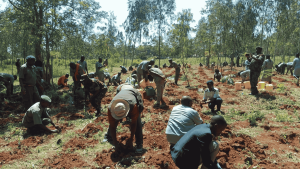Tree Adoption Foundation (TAF) is in the process of conducting extensive reforestation in various counties across Kenya. Reforestation is the process of planting trees in areas where forests have been depleted or degraded due to human activities like logging, agriculture, urbanization, or natural disasters. This process involves restoring natural ecosystems to their original state or planting new forests to improve environmental conditions. We are currently advocating for various methods to achieve this. One of the methods involves natural regeneration (allowing forests to regrow naturally). Secondly, through partnerships with schools and the public, we are performing active intervention which involves tree planting and afforestation.
Reforestation and Global Warming
TAF believes that, by aggressively engaging in reforestation, the world stands a better chance of combating Global warming and its effects. Trees absorb carbon dioxide (CO₂), a major greenhouse gas, during photosynthesis. By capturing and storing CO₂ in their biomass, trees help mitigate global warming by reducing the amount of this gas in the atmosphere. Secondly, forests provide shade and release water vapor through a process called transpiration. This helps to lower temperatures and maintain cooler local climates, reducing the urban heat island effect. In addition, in urban settings, trees can reduce the need for air conditioning by providing shade, thus lowering electricity consumption and associated CO₂ emissions.
Environmental Benefits of Reforestation
Through environmental assessments and the literature behind reforestation, TAF believes that reforestation has a lot of environmental benefits. This can be summed up as:
- Biodiversity Conservation: Reforestation creates habitats for wildlife, supporting diverse ecosystems. Healthy forests are home to thousands of plant and animal species.
- Improved Air Quality: Trees filter air pollutants, such as nitrogen dioxide (NO₂), sulfur dioxide (SO₂), and particulate matter, improving the quality of the air we breathe.
- Soil Conservation: Forests prevent soil erosion by stabilizing the ground with their roots. This helps maintain soil fertility and reduces the risk of landslides and desertification.
- Water Cycle Regulation: Trees play a vital role in regulating the water cycle by improving groundwater recharge, reducing runoff, and preventing floods.
- Combatting Desertification: Reforestation in arid and semi-arid regions can help reverse desertification by improving soil moisture and reducing land degradation.


